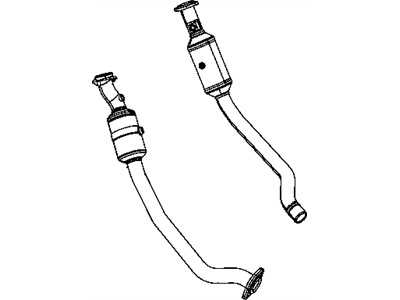This part fits the vehicle you selected:
My Vehicle: 2011 Jeep Grand Cherokee 8 Cyl 5.7L MDS VVT; 5-Speed Automatic Transmission 545RFE; Limited 4WD
Change VehicleThe vehicle options this part fits:
- Fitting Vehicle Options: 74 - SPORT UTILITY 4-DR TYPE #4, J - JEEP - 4WD
Mopar 68057630AB CONVERTOR-Exhaust
2011 Mopar 68057630AB

- Part DescriptionPipe And Converter Exhaust
- Right [NA1] Or [NAE]
- Replaced By68414796AA
- ManufacturerMopar
This part fits the vehicle you selected:
2011 Jeep Grand Cherokee 8 Cyl 5.7L MDS VVT; 5-Speed Automatic Transmission 545RFE; Limited 4WD
The vehicle options this part fits:
- Fitting Vehicle Options: 74 - SPORT UTILITY 4-DR TYPE #4, J - JEEP - 4WD
$1252.50 MSRP: $1840.00 1
You Save: $587.50 (32%)
Core Charge: $200.00
Product Specifications
| Brand | Genuine Mopar |
| Manufacturer Part Number | 68057630AB |
| Part Description | Pipe And Converter Exhaust |
| Item Weight | 12.20 Pounds |
| Condition | New |
| Fitment Type | Direct Replacement |
| Manufacturer | Mopar |
| SKU | 68057630AB |
| Warranty | This genuine Mopar part is guaranteed by Mopar's factory warranty. |
| Shipping & Return | Shipping Policy Return Policy |
Warning: California’s Proposition 65
Customer Questions & Answers
- Q:Does this part fit my vehicle? Posted by MoparPartsGiant Specialist
- A:You can Select Your Vehicle to check if 68057630AB fits your vehicle.Posted by MoparPartsGiant Specialist
- Q:How to Replace a Catalytic Converter? Posted by Customer
- A:Because of a Federally-mandated extended warranty which covers emission-related components such as the catalytic converter, check with a dealer service department before replacing the converter at your own expense. A catalytic converter (or catalyst) is an emission control device in the exhaust system that reduces certain pollutants in the exhaust gas stream. There are two types of converters. An oxidation catalyst reduces hydrocarbons (HC) and carbon monoxide (CO). A reduction catalyst reduces oxides of nitrogen (NOx). A catalyst that can reduce all three pollutants is known as a "Three-Way Catalyst" (TWC). All models covered by this manual are equipped with TWCs. The test equipment for a catalytic converter (a loaded-mode dynamometer and a 5-gas analyzer) is expensive. If you suspect that the converter on your vehicle is malfunctioning, take it to a dealer or authorized emission inspection facility for diagnosis and repair. Whenever you raise the vehicle to service underbody components, inspect the converter for leaks, corrosion, dents, and other damage. Carefully inspect the welds and/or flange bolts and nuts that attach the front and rear ends of the converter to the exhaust system. If you note any damage, replace the converter. Although catalytic converters don't break too often, they can become clogged or even plugged up. The easiest way to check for a restricted converter is to use a vacuum gauge to diagnose the effect of a blocked exhaust on intake vacuum. Connect a vacuum gauge to an intake manifold vacuum source. Warm the engine to operating temperature, place the transaxle in Park (automatic models) or Neutral (manual models) and apply the parking brake. Note the vacuum reading at idle and jot it down. Quickly open the throttle to near its wide-open position and then quickly get off the throttle and allow it to close. Note the vacuum reading and jot it down. Do this test three more times, recording your measurement after each test. If your fourth reading is more than one in-Hg lower than the reading that you noted at idle, the exhaust system might be restricted (the catalytic converter could be plugged, OR an exhaust pipe or muffler could be restricted). Raise the vehicle and place it securely on jackstands. Spray a liberal amount of penetrant onto the threads of the exhaust pipe-to-exhaust manifold bolts, the clamp bolt that connects the two parts of the crossover pipe and the clamp bolt that connects the pipe behind the right catalyst to the muffler. Wait awhile for the penetrant to loosen things up. On models so equipped, unbolt and remove the skid plate and transmission crossmember, if necessary. While you're waiting for the penetrant to do its work, disconnect the electrical connectors for the upstream and downstream oxygen sensors and remove both oxygen sensors. Unscrew the upper exhaust pipe-to-exhaust manifold flange bolts. If they're still difficult to loosen, spray the threads with some more penetrant, wait awhile and try again. To loosen the clamp that secures the slip joint between the two sides of the crossover pipe between the two catalysts, back off the nut. If it's still difficult to loosen, spray the threads with some more penetrant, wait awhile and try again. If you're removing or replacing the right catalytic converter, you'll also have to loosen the clamp that secures the slip joint between the right exhaust pipe and the pre-muffler. Again, if it's still difficult to remove, spray the threads with more penetrant, then wait awhile and try again. Remove the catalytic converter assembly. Remove and discard the old flange gasket. Installation is the reverse of removal. Be sure to use a new flange gasket and new bolts at each exhaust manifold mounting flange. The manufacturer also recommends using new clamps at the slip joints. Coat the threads of the clamp and the exhaust manifold bolts with anti-seize compound to facilitate future removal. Tighten the fasteners securely.Posted by MoparPartsGiant Specialist
If you have any questions about this product, please don't hesitate to ask us. We will be happy to help you!
Why choose Mopar Parts Giant
- Dedicated Service
Your complete satisfaction is our #1 goal
- Lowest Prices
Best deals on genuine OE parts from dealerships
- Fast Delivery
Orders are processed and delivered promptly
